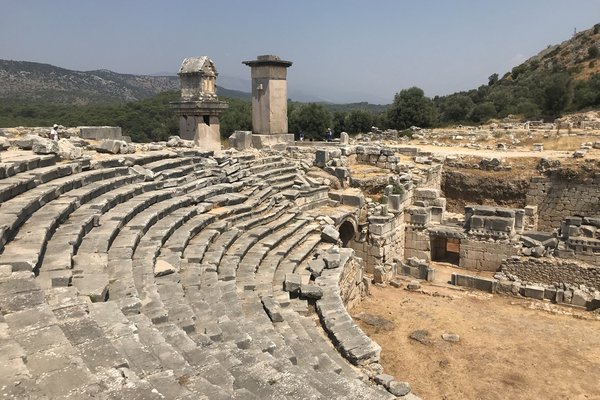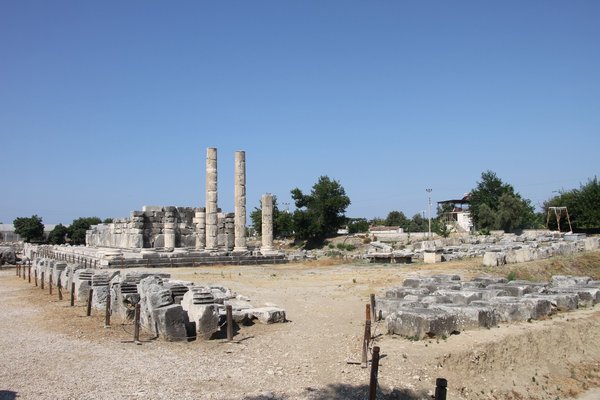Turkiye
Xanthos-Letoon
Xanthos-Letoon comprises two archeological sites that represent the Lycian civilization.
Xanthos was a center of culture and commerce in ancient Lycia. Their artwork is well known, the most famous being the Nereid Monument (now in the British Museum). The sanctuary of Leto, the Letoon, was one of the most important Lycian religious centers. At both sites, multilingual inscriptions have been found, which have provided crucial keys in deciphering the Lycian language.
Community Perspective: At Xanthos, it is worth concentrating on the Lycian aspects (there are Hellenistic/Roman ones as well), especially the tombs at the Necropolis. Unfortunately, most sculptural highlights at the acropolis are replicas. Clyde and Solivagant also took the detour to Letoon, “a dispiriting place”. J_neveryes has explained the public transport options to both locations.
Site Info
Official Information
- Full Name
- Xanthos-Letoon (ID: 484)
- Country
- Turkiye
- Status
-
Inscribed 1988
Site history
History of Xanthos-Letoon
- 1988: Inscribed
- Inscribed
- Type
- Cultural
- Criteria
- ii
- iii
Links
- UNESCO
- whc.unesco.org
- Official
-
- muze.gov.tr — Xanthos
- Related
-
- livius.org — Xanthus - by Livius, Articles on Ancient History
All Links
UNESCO.org
- whc.unesco.org — whc.unesco.org/
Official Website
- muze.gov.tr — Xanthos
Related Resources
- livius.org — Xanthus - by Livius, Articles on Ancient History
News Article
- June 6, 2019 hurriyetdailynews.com — Xanthos mosaics unprotected
- Aug. 17, 2017 hurriyetdailynews.com — Mystic Egyptian seal found in Letoon
- July 27, 2011 hurriyetdailynews.com — A Turkish archaeology team has taken over excavations in the ancient city of Xanthos due to the slow progress under the guidance of French teams
Community Information
- Community Category
- Archaeological site: Classical (other)
Travel Information
Recent Connections
-
Curse Inscriptions
Inscription on the Lycian rock-cut tomb…
-
Perfect Inscriptions
1988 -
Stylite
"The space inside the tomb was later oc…
Connections of Xanthos-Letoon
- Individual People
-
-
Emperor Hadrian
Letoon - Emperor Hadrian founded an emperor worship cult at the site
-
- Trivia
-
-
In the British museum
"The city (of Xanthos) was rediscovered in 1838 by Charles Fellows. He brought 70 boxes of reliefs and sarcophagi on board the ship HMS Beacon, which he shipped to the British Museum" (Wiki)- in particular the Nereid Monument -
Total Solar Eclipse since Inscription
29 March, 2006
-
- History
-
-
Ancient Anatolian cultures
LyciansSee en.wikipedia.org
-
Located in a Former Capital
Capital of Lycia -
Byzantine Empire and Civilization
Letoon - remains of a Byzantine church
-
- World Heritage Process
-
-
Perfect Inscriptions
1988 -
Extended from original TWHS
Originally only Xanthos. Letoon added at inscription -
Already inscribed still on T List
Xanthos is a component in the Turkish TWHS Ancient Cities of Lycian Civilization.
-
- Religion and Belief
-
-
Curse Inscriptions
Inscription on the Lycian rock-cut tomb TL 75,"...If one places anyone else [therein] on top, then thi[s] qla will strike him – and Malija – and the oaths of the minti."
-
Nymphaeum
Letoon -
Stylite
"The space inside the tomb was later occupied by an early Christian hermit. Fellows noted that the backs of the reliefs still bore the remains of the hermit's religious paintings and monograms. Fellows speculates that this man was a disciple of Simeon Stylites (390–459 AD), one of the eponymously named Christian ascetics known as stylites, who lived on the top of tall columns." (Wiki on Harpy Tomb), "... becoming a bastion of Christianity where strange Byzantine ascetics known as ‘pillar-saints’ moved into the old pagan tombs." (see link) -
Goddesses
Sanctuary to Leto
-
- Human Activity
-
-
Writing systems
many texts in Lycian and Greek, including several bilingual texts that are useful in the decipherment of Lycian -
Multilingual inscriptions
Lycian, Aramaic and Greek -
Ongoing Archaeological digs
University Laval Quebec (Canadian Epigraphic Mission) Reports up to 2010.
-
- Constructions
-
-
Stelae
Xanthian Obelisk, an important archaeological find pertaining to the Lycian language.See en.wikipedia.org
-
Tombs
Xanthos - Harpy Tomb and Pillar Tomb -
Necropolises
Xanthos -
Theatres and Opera Houses
Xanthos - amphitheatre
-
- Timeline
-
-
Built in the 4th century BC
trilingual inscription dates to 358 B.C.; Nereid Monument "is thought to have been built in the early fourth century BCE" (wiki)
-
News
- hurriyetdailynews.com 06/06/2019
- Xanthos mosaics unprotected
- hurriyetdailynews.com 08/17/2017
- Mystic Egyptian seal found in Leto…
- hurriyetdailynews.com 07/27/2011
- A Turkish archaeology team has tak…
Recent Visitors
Visitors of Xanthos-Letoon
- Alexander Barabanov
- Alexander Lehmann
- A. Mehmet Haksever
- Argo
- Atila Ege
- Badwater
- bergecn
- Bill Koo
- Bin
- Can SARICA
- Cheryl
- christof
- Christravelblog
- Clyde
- Corinne Vail
- Csaba Nováczky
- CynthiaSam
- Dimitar Krastev
- Elaine McArdle
- Els Slots
- Erik Jelinek
- Evgenii
- Fan Yibo
- Farinelli
- Felicité
- Francky D'Hoop
- George Gdanski
- Gernot
- Harry Mitsidis
- Hasco
- henryjiao18
- Hubert
- Iain Jackson
- Ivan Rucek
- Jan-Willem
- Jarek Pokrzywnicki
- Jawnbeary
- Jeffrey Chai
- J_neveryes
- Judit Andrea Juhász
- KarenBMoore
- Kbecq
- Kevin McFarland
- Kjlauer
- Knut
- Kurt Lauer
- Laurine
- Lucas Del Puppo
- Ludvan
- Luis Filipe Gaspar
- Luke LOU
- Maciej Gil
- marcel staron
- Martina Rúčková
- Michael Turtle
- Milan Jirasek
- Miloš Tašković
- nan
- Nihal Ege
- Patrik
- Paul Schofield
- Philipp Leu
- Philipp Peterer
- Rafał Kałczuga
- Randi Thomsen
- Risson
- Roger Ourset
- Roman Bruehwiler
- Sclowitz
- Solivagant
- Stanislaw Warwas
- Svein Elias
- Szucs Tamas
- Tammy Gouldstone
- Tarquinio_Superbo
- Tatiana Nikulnikova
- Thomas Buechler
- Thomas van der Walt
- Tikhon Puliaev
- Tim Allen
- Timothy C Easton
- Vanessa Buechler
- Westwards
- Wojciech Fedoruk
- Yevhen Ivanovych
- Zoë Sheng
Community Reviews
Show full reviews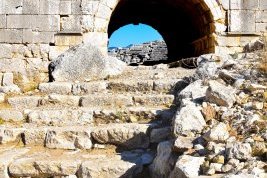
Less visited sites of a lesser known ancient civilization, Letoon and Xanthos are more intriguing than they appear at a first glance. For those visiting the Turquoise Coast of Turkiye, Letoon and Xanthos combine to make a worthwhile day trip.
Letoon
I based myself in Fethiye, which is a small city with good amenities. From its bus station, I easily found a minibus to Kumluova village and let the driver know that I wished to visit Letoon. From where he dropped me off, it was an easy 900 metres walk to the ancient sanctuary. Letoon appeared to me to be well-cared for and had a modern administrative and ticket office on-site. I was the sole visitor for most of my visit.
Not much remains of Letoon's three temples, but its Hellenistic theatre (photo) from 2nd century BCE is well-preserved. The theatre's two vaulted passages are its highlights.
Although Letoon lacks the 'wow' factor, there are small details that one can discover that will make a visit more interesting. For example, near the closed-off entrance to the northeast passage of the theatre, there is a Roman tomb with a carved representation of its toga-clad occupant.
Letoon is a small site and an hour should be sufficient to explore it.
Xanthos
With neither my own vehicle nor intimate knowledge of the minibus routes, I found it easier to simply walk from Letoon to Xanthos. The route between the two sites are part of the much-heralded …
Keep reading 0 comments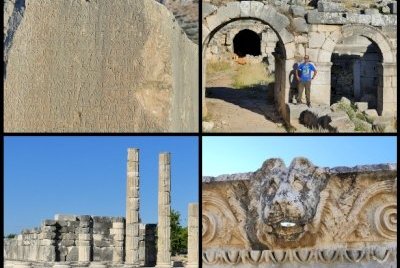
I visited both locations of this WHS in Spring 2021. Of the two, Letoon seems to be the less visited. The original highlights of these two locations are now to be found mainly in museums: a whole hall in the British Museum for Xanthos and the Lycian trilingual (Lycian, Aramaic and Ancient Greek) stele in the Fethiye Museum.
At the Archaeological Site of Letoon, upon close inspection, you'll be able to spot some worthwhile details among the original remains (think Greek WHS remains) of what was once one of the most important religious centres in the region. The site is located south of the village of Kumluova and lies approximately four kilometres south of Xanthos along the Xanthos River. The foundations of three temples are clearly visible, with the Temple of Leto in the best condition, and an almost intact theatre.
At the Archaeological Site of Xanthos, most highlights are replicas such as the impressive Harpy Tomb reliefs (which are in the British Museum). However there are still some other original highlights such as the amphitheatre, the Lycian Dancers' sarcophagus, and the Xanthian Obelisk, a trilingual monolith recording an older Anatolian language conventionally called Milyan, Lycian and Greek. For me, the trilingual stelae alone at both sites were absolute highlights and worth the visit. While Letoon was fenced off, Xanthos (at least most of it) wasn't and having arrived very early in the morning I could visit at leisure for free well ahead of the official opening time.
Keep reading 0 comments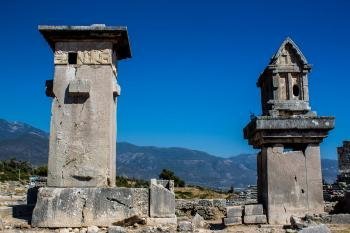
Even today, the capital of Lycia gives you the impression that this was a civilisation that was able to do things on a grand scale. The twin sites of Xanthos and Letoon are only about 60 kilometres from Fethiye but are slightly tricky to get to if you don’t know what you’re doing. They are not an obvious stop for tourists passing through although tour buses of Turkish locals are more likely to stop there.
It’s a pity, because both locations (which are about five kilometres apart and I easily walked between) have a lot to offer. Not only are they an interesting insight into the Lycian culture but also they show the influences that came from both the west and east.
Keep reading 0 comments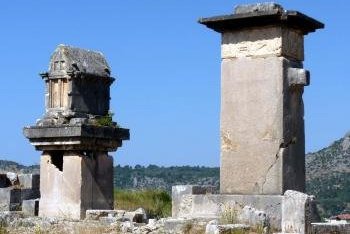
It seems somewhat surprising that, of all the “Classical” sites on or near the Turkish coastline the so-called “twin site” of Xanthos-Letoon should have been Turkey’s first choice for inscription way back in 1988. It was accompanied that same year by Hierapolis but many other apparently more “significant” sites in the region had to wait and indeed many still do.
I say “Classical” but this site is badged via its OUV very much as a “Lycian” site albeit, inevitably, with significant Hellenistic and Roman aspects which resulted from its location, its conquest over the centuries and the process by which the Lycians “assimilated” Greek culture. Heroditus said that the Lycians came originally from Crete but it is thought more likely now that they were an Anatolian people and that this explains the existence of their own very different language and script. A further important event in the site’s history was its conquest by the Persians around 540BC which provided yet another cultural infusion.
Xanthos-Letoon thus hovers between being “yet another” Classical site and being something more uniquely “Anatolian”. As you visit you will see the standard Agora, Roman amphitheatres, Nymphaeum, Temples to Apollo etc as well as some remains of Byzantine churches but there are also many aspects which are uniquely Lycian. And even the Hellenistic/Roman aspects often overlay earlier Anatolian remains/beliefs.
Thus, one of the main “claims to fame” of the sites has been the light that excavations there have shone on the Lycians – particularly …
Keep reading 0 comments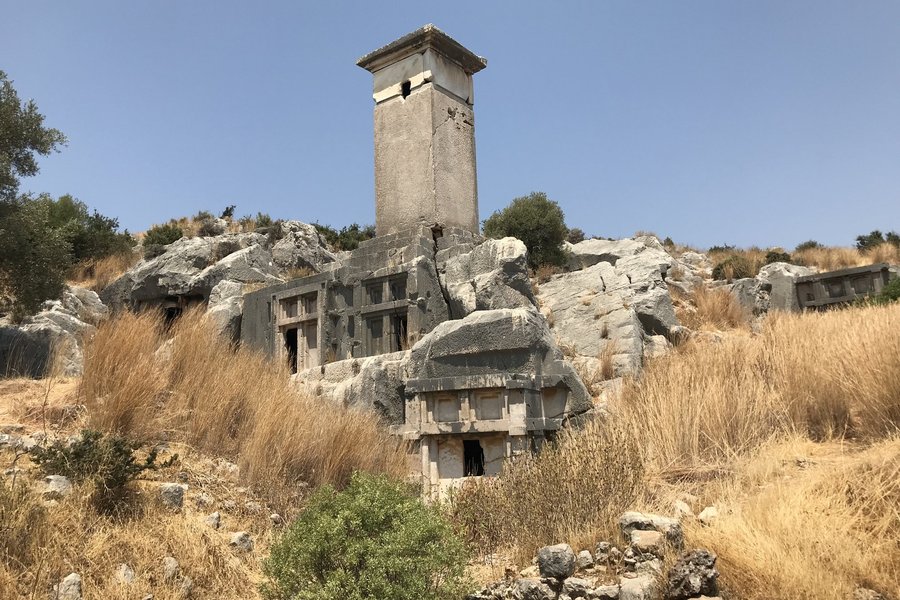
Last November I caught the bus in Antalya with the intention to go to Patra, and explore the UNESCO sites. The bus driver knew I was getting off in Patra, so sure enough his shouting at me made me aware that this was the stop--with a sign that read 6 km. to Patra. I had not gone 300 yards before I was offered a ride to my hotel. This time of year there are no buses to the sites, so I started back down the road to the highway, and once again secured a bit of seat on the back of a motorcycle, that took me to Xanthos.
If you are an ancient Greek " junkie," the site is breathtaking, and in November you have it all to yourself save for a few goats, and the mandatory dog that goes everywhere with you. I new a good bit of the grim history of this site, and it all made it more moving. Its a perfect place for reflecting on the history of those times, without the pressure of crowds.
Caught a bus back to the intersection to Patra, and once again was provided a ride by these gracious people. It was apparently olive picking season, so back at my hotel I joined in on pitting olives.
Keep reading 0 comments
Xanthos was besieged and occupied by the Persians, the Greeks, the Romans and the Byzantinians and has some nice excavations, mostly done by French archeologists since 1950.But important structures like the fabulous Neired monument have been kidnapped to the British museum in London and Xanthos is left with bare rocks.The large amphitheater is a wonderful building and well worth the visit in its own.
Transportation to Xanthos is easy, with local minibuses leaving to and from Fethiye and Kalkan hourly to the village of Kinik.From there its a 1.5km walk uphill.
Keep reading 0 comments
I visited Xanthos on 11.10.03 by taxi from Patara together with 2 other hotel guests. The site was virtually deserted and we spent a fascinating 3 hours exploring it. The entrance fee was about £ 2.50 and well worth it.
It was wonderful to visit Xanthos without the usual tourist crowds obscuring the ancient structures.I must go to the British Museum now to see the articles removed to there (for safe keeping?!) in 1840
The rock tombs were the most impressive for me as I had never seen one close up and here were lots all over the hillside.A helpful Turk was very good at explaning what we were looking at and pointing out particular features which we would have missed had he not been there. He was not intrusive like the Egyptians are in Luxor and was well worth his tip.
Patara a few miles away is absolutely fescinating and again almost deserted in early October.
I spent hours exploring the various buildings with the aid of a book written in 2000 by Prof.Dr. Fahiri Isik who is excavating the site.
I have hundreds of fantastic photos to refresh my memories of the area and hope to visit again.
Keep reading 0 comments
